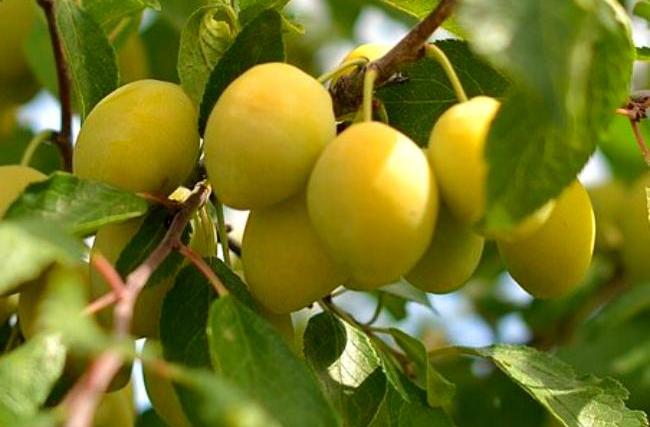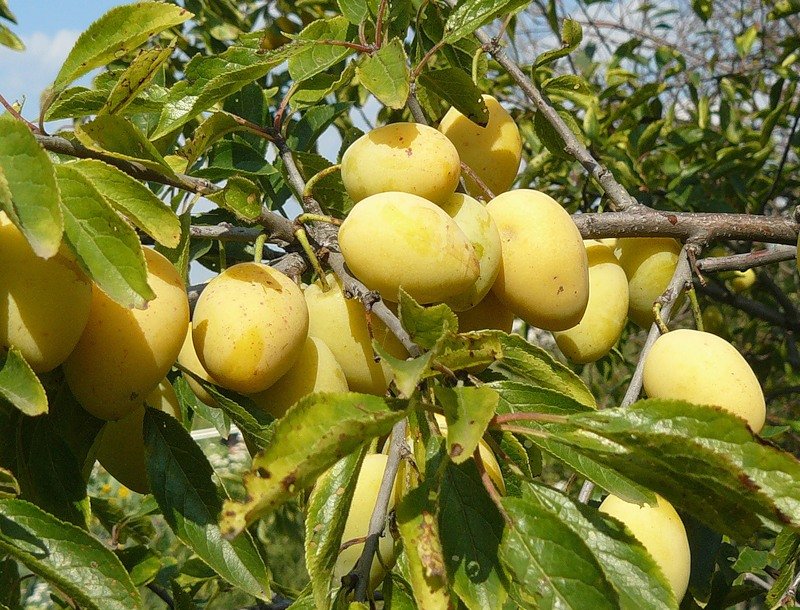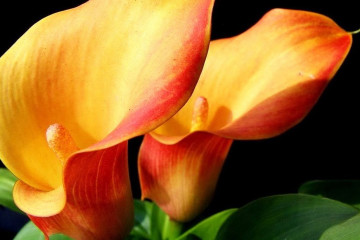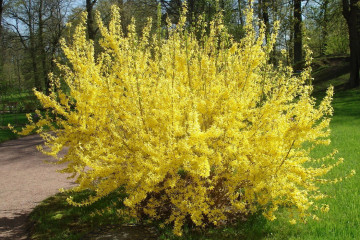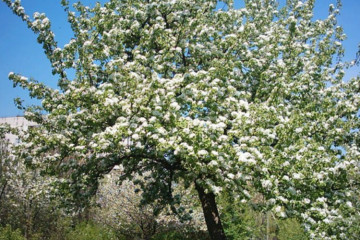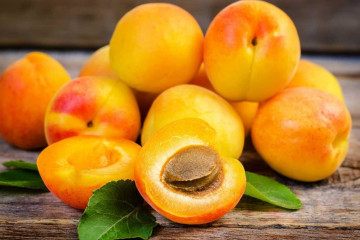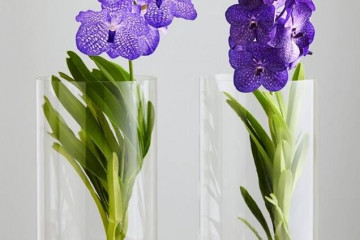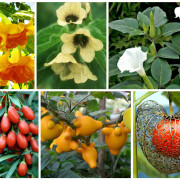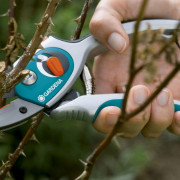Yellow plum: what are the varieties called, description and care
Content:
The yellow plum is as popular as the blue one. In addition, there are a large number of different varieties that differ in taste. Not many people know that yellow varieties have been bred for quite some time, but they are not found as often as blue ones. Moreover, the former are often even tastier than the latter. This variety has some features that should be considered when planting and caring for a plant.
How the yellow plum blooms and bears fruit
Yellow plums bloom just like all other varieties in spring. The flower petals are creamy. The crop begins to bear fruit closer to autumn, but some varieties can bear fruit at an earlier time.
If you wish, you can grow a plant in the middle lane and even in the Leningrad region, but in Asia it will grow and bear fruit better.
The best varieties of yellow-fruited plums
Experts have bred many different varieties of yellow plums. They have some differences that are worth knowing for those wishing to grow a similar crop. The most famous varieties:
- Jubilee Altai. Plums can reach a weight of about 15 grams and are oval in shape. The skin tone is more intense than other varieties. The fruits are very fragrant, the presence of a waxy coating is noticeable. Medium early variety, winter hardy, but does not like drought.
- Golden Large. Late variety, bears fruit in September. Fruits are round in shape, yellow with ruddy casks. There is a slight waxy coating on the surface. It tastes sweet and sour. The variety is resistant to frost, drought and disease.
- Early Loshitskaya. An early variety, self-fertile. Plums are medium in size, weighing 35 grams. Fruit color is yellow-green, honey notes are present in the taste. It tolerates winter well, does not freeze.
- Renklode Kolkhoz. Plums are not small, they reach 35 grams. The pulp is yellow, sweet with a slight sourness. The variety bears fruit abundantly, tolerates frosts and diseases. The tree grows well and quickly.
- Memory of Timiryazev. Late ripening and large-fruited variety. The crop can be harvested at the end of August. The fruits are large, oval in shape. The main color is yellow, the cover color is pink-red. Plums are sweet and sour, with a weak aroma. The tree tolerates drought well, is resistant to diseases.
Self-fertile varieties. They have one indisputable advantage - there is no need to plant a tree nearby, which will be a pollinator.
In addition, there is also a list of popular varieties:
- Fast-growing. This is the name of the early variety, the fruits ripen quickly. Fruits reach 20-28 grams, have a rounded shape. The color is yellow, with an integumentary red tint. The taste is sour-sweet, the pulp is juicy and aromatic. The first fruits can be obtained in mid-August.
- Ochakovskaya white. Refers to varieties of medium ripening. A very tasty variety, therefore it is especially popular with gardeners. You can harvest in early September. The average weight is approximately 45 grams.Description of the Ochakovskaya yellow plum can be found on many sites on the Internet.
- Honey (White Honey). An early variety with very tasty fruits. The pulp resembles flower honey, which is why the culture is quite popular. There is a slight sourness. Plums are round in shape, in mass reach from 30 to 50 grams.
- Morning. An early variety, self-fertile. The crop can be harvested at the beginning of August. Fruits are medium in size, weighing up to 30 grams. It is relatively resistant to diseases, it is hard to tolerate frost - flower buds suffer.
- Egg yellow. It is considered the oldest and rarest variety of this culture. It has many flaws, so only collectors grow it. The fruit is quite large, but sour. They are stored for a very short time, therefore they require quick processing, for example, jams, jams.
- Tatar yellow. Mid-season variety with small plums. Fruit weight does not exceed 15 grams. The pulp is medium juicy and has a sweet and sour taste. Ripe fruits often fall off.
- Minsk. Late variety, begins to bear fruit at the age of 6. The fruits are oblong and light yellow in color. The pulp is juicy, aromatic and sweet. The variety is frost resistant.
- Yakhontovaya. It belongs to tall varieties, it can grow up to 6 meters. Fruit weight is approximately 45 grams. The taste of yellow-pink plums is sweet with a slight sourness, the pulp is very juicy.
- Angelina. A tree with this name can grow up to 3 meters in height. The fruits are very large, like a ball, they can reach up to 115 grams. The pulp is very juicy, sweet and sour. Fruiting begins in the second year.
- Giant. Plum with large fruits reaching 40 grams. The tree is tall, begins to bear fruit in the third year. The fruits are tasty, sweet and sour and juicy.
- Hungarian Bogatyrskaya. The tree is medium in size. Plums reach up to 40 grams in weight, the skin is thick, the flesh is dense with a honey flavor. The variety tolerates frost well, but suffers from drought.
On the Internet, you can also find a description of the Selivanih plum and others; there is a mountain yellow plum.
How to choose the right yellow plum variety
The choice of culture depends on various factors. First of all, it is recommended to pay attention to climatic conditions - some varieties do not tolerate cold well, for others, heat and drought are destructive.
Site selection and soil preparation for planting
For yellow plums, it is best to choose sunny areas. Clay soils are best suited. It should be borne in mind that the culture does not like flooded areas, therefore, plants should not be planted in places with a high level of groundwater.
Depending on the variety, it is necessary to correctly calculate the distance from the crop to other plants. It must be at least three meters.
Requirements for planting material
Before planting, seedlings must be carefully inspected and those that show signs of disease or damage to be discarded.
Features of planting and growing yellow-fruited plums
It is best to plant new young plants between September and October. Planting in the spring is allowed. However, in such a case, she will bloom in the first year, which does not have a good effect on her condition and health. In the summer, planting is not carried out.
Caring for a yellow self-fertile plum
Caring for yellow plums is similar to caring for blue crops. The seedling must be watered on time, weeds must be removed near the tree, and the earth is loosened. It is recommended to mulch the soil in the fall to keep the roots from freezing in the winter.
Top dressing is applied 4 times per season, for this they use various complex fertilizers.
Pollinators for yellow plum
Pollinating trees are essential for self-fertile varieties. It is necessary to choose them according to the flowering time. It is also recommended to spray the flowers with honey solutions to attract more bees.
Prevention and treatment
It is important to pay attention to the drain and adhere to proper care in order to avoid the appearance of various diseases. Danger and harm to the culture are scab, powdery mildew, root cancer, fruit rot and similar diseases. It is recommended to treat wood with special solutions.
The yellow plum is a popular crop and is easy to grow. The most important thing is to choose the right seedling correctly and comply with all care conditions. With a little diligence, you can get an excellent harvest with high taste. It is possible to grow culture both in the Urals, in Siberia, and in the Moscow region, as well as in other regions of Russia.
